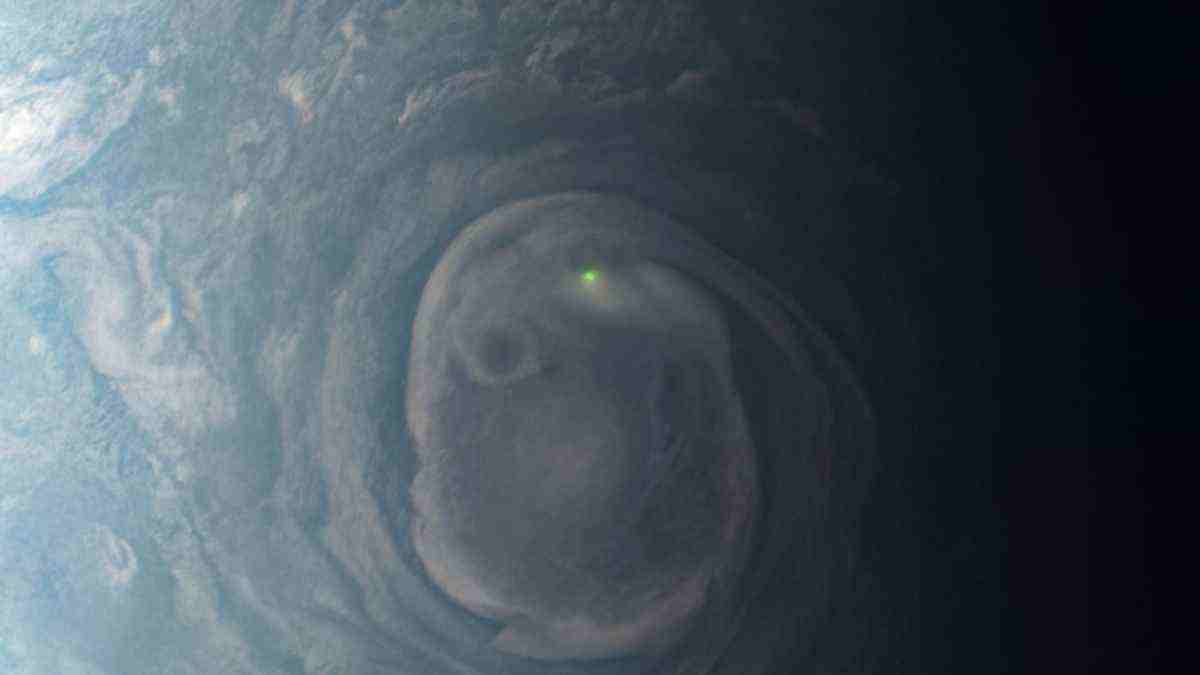UNITED STATES: NASA’s Juno spacecraft, on a mission to unravel the secrets of Jupiter, has once again astonished the world with a captivating image capturing a bolt of lightning near the gas giant’s north pole. This extraordinary photograph, taken during Juno’s 31st close flyby on December 20, 2020, has since gone viral, leaving millions of people in awe of the wonders of our universe.
Utilising unprocessed data from Juno’s JunoCam instrument, citizen scientist Kevin M. Gill skillfully processed the image that recently surfaced online. Gill’s expertise and dedication to uncovering the mysteries of our solar system have allowed the world to witness the remarkable glow of a lightning bolt near Jupiter’s enigmatic north pole.
According to a statement released by NASA, the Juno spacecraft was positioned approximately 19,900 miles (32,000 kilometers) above Jupiter’s mesmerizing cloud tops when this captivating snapshot was taken. The craft was traversing at a latitude of about 78 degrees, gradually closing in on the colossal planet.
Unlike lightning on Earth, which primarily originates from water clouds and frequently occurs near the equator, Jupiter’s lightning phenomena are believed to manifest within clouds consisting of an ammonia-water solution. Furthermore, these awe-inspiring bolts of electricity are most commonly observed near the planet’s poles.
The intriguing similarities and differences between the lightning processes on Earth and Jupiter have long captivated scientists. The valuable data collected by Juno is providing new insights into these phenomena, despite the dramatic disparities between the two celestial bodies.
Planetary scientist Ivana Kolmasova, the lead author of a recent study published in the journal Nature Communications, explains that lightning on Earth originates from electric discharges initiated inside thunderclouds. As ice and water particles collide within these clouds, they become charged, creating layers of particles with the same polarity. This accumulation of charge eventually leads to the formation of a powerful electric field that triggers the discharge of lightning. However, the exact intricacies of this process within thunderclouds are still not entirely comprehended by the scientific community.
Jupiter, known for its vibrant appearance adorned with colorful stripes and intense storms, is primarily composed of hydrogen and helium, with traces of other gases. With a diameter of approximately 88,850 miles (143,000 kilometers), it reigns as the fifth planet from the sun, captivating astronomers and space enthusiasts alike.
NASA’s Juno spacecraft has been diligently orbiting Jupiter since 2016, tirelessly gathering crucial information about the gas giant’s atmosphere, internal structure, magnetic field, and the surrounding regions influenced by its magnetism. With each close flyby, Juno provides humanity with an unprecedented glimpse into the captivating wonders of Jupiter, unraveling its mysteries one mission at a time.
As the mesmerizing image of lightning on Jupiter continues to circulate, it serves as a powerful reminder of the immense beauty and grandeur that exist beyond our planet. Thanks to the diligent efforts of scientists, citizen scientists like Kevin M. Gill, and cutting-edge technology like Juno, humanity’s understanding of the cosmos is expanding, revealing the enchanting secrets of our celestial neighbours.
The viral image of Jupiter’s lightning serves as a testament to the wonders that await us in the vast expanse of space, fueling our curiosity and inspiring future explorations into the unknown.
Also Read: NASA and Boeing Unveil X-66A: A Groundbreaking Sustainable Flight Demonstrator



